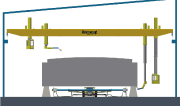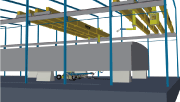Blast cleaning large steel objects such as in shipyards and the offshore industry is a tedious and dangerous process that is often carried out manually. Special robots and manipulators with high blast power have been developed for these applications. These machines can move around in an abrasive environment and do the work typically done by manual blasters.
At the request of several shipyards and offshore companies, Blastman Robotics has developed a solution for efficient blast cleaning with robots for very large steel structures. For this purpose, the individual axis ranges of the existing blast cleaning robots have been significantly increased. In addition, a completely new mobile blast-cleaning unit has been developed that can blast clean very large objects highly efficiently and very flexibly from underneath, since such components cannot normally be turned due to their size.
Two blast-cleaning robots with 32 m wide bridges and over 8 m long telescopic arms were delivered to C&C Marine shipyard in the USA. C&C Marine manufactures barges up to 100 m long and 30 m wide. These robots, with separate control cabins, reach all areas blasted on top and from the side. At the same time, one of the newly developed Blastman MBU (Mobile Blast Unit) blasts the underbody of the barge (Figs. 3 and 4). A second robot system with even larger dimensions was manufactured for a Chinese customer who uses it to blast underwater tunnel segments. Blastman Robotics is currently working with two Asian shipyards and a large offshore supplier from the Middle East on using this modern robot technology to blast clean even larger ships and oil rigs.
Automated blasts better
A major advantage of the blast-cleaning robots is their fatigue-free work, even with high workloads. Due to the large blasting nozzles and the high blasting pressures, each robot achieves blasting outputs of over 200 m²/h, which is more than 10 times that of an average worker. Through the simultaneous use of e.g. two gantry type robots and a mobile blasting unit, the time and cost of blasting processes in a shipyard can be significantly reduced. At the same time, quality and safety are increased significantly. Additionally, after blasting, the robot can quickly and very efficiently clean the object of abrasive residues and dust with compressed air. This means that all stages of the blast-cleaning process can be done without extensive scaffolding and lifting equipment.
Movable and flexible
Blastman‘s Mobile Blast Unit is a moving blast cleaning robot that was specially developed for the blast cleaning of ships and offshore components. It is operated completely electrically, and all axes and movements are servo-controlled. The intelligent user interface and innovative drive mechanism of the Blastman MBU offers an excellent flexibility for various blasting applications. The operator, who sits in the air-conditioned and ergonomically designed cabin, controls the two blast heads and nozzles on the boom, as well as the movements of the Blastman MBU very easily and efficiently using joysticks and a touchscreen. The wheels on the two axles can be steered independently of one another by ± 30 °, which results in great flexibility.
Reproducible blast cleaning results
The effective and high-quality preparation of metallic surfaces before the application of corrosion and wear protection layers is an important step in surface protection, as it significantly determines the protective effect of the coating. By automating the blasting process, reproducible cleaning results of consistently high quality can now be achieved even with very large objects.
The Blastman MBU can work via parameter programming and the gantry robots can be programmed very easily using teach-in or point-to-point methods. Offline programming can be done by using 3D models of the workpieces. This is the most efficient method of programming since programs can be made well in advance and simulated to ensure perfect function. At the same time, the cleaning processes are optimized offline in terms of quality and time, which significantly improves the costs and efficiency of blast cleaning processing.
For Information:
Blastman Robotics Ltd
Heiko Reski
Schinkelstr. 55, 40211 Düsseldorf
Germany
Tel. +49.211.490 890
E-mail: heiko.reski@blastman.com
www.blastman.com


































